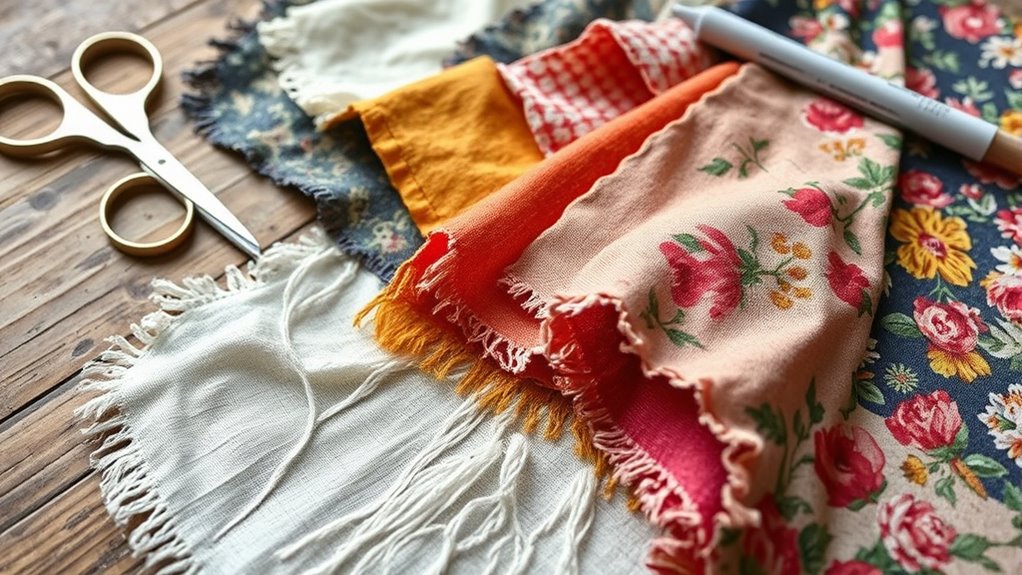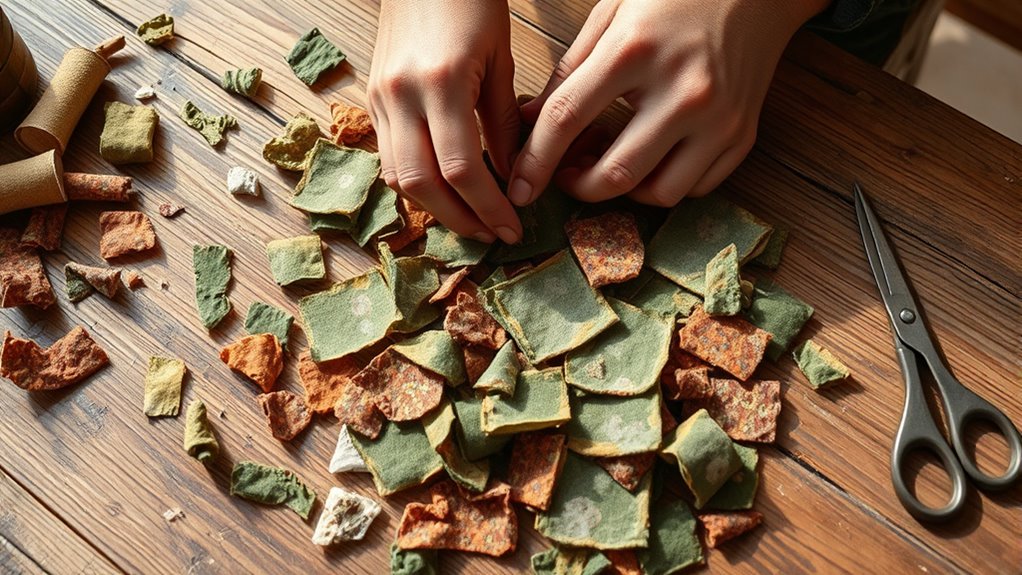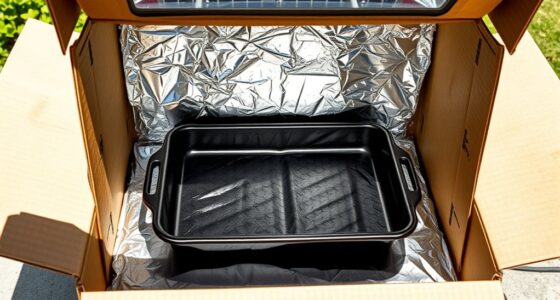To make organic cloth napkins from scrap fabric, first select natural fibers like cotton or linen that are free from chemicals. Cut scraps into uniform sizes, around 12×12 inches, and sew the edges with zigzag or serging stitches to prevent fraying. Use earthy tones or dye with natural dyes for a eco-friendly look. Focus on simple, durable finishes to assure longevity. If you keep exploring, you’ll discover more tips to craft beautiful, sustainable napkins from your scraps.
Key Takeaways
- Select natural, chemical-free fabric scraps like cotton or linen for eco-friendly napkins.
- Cut scraps into uniform sizes, such as 12×12 inches, for consistent sewing.
- Use natural dyes or leave fabrics in their original tones for an organic look.
- Finish edges with zigzag stitches or serging to prevent fraying and ensure durability.
- Incorporate varied textures and earthy colors to enhance visual appeal and sustainability.

Using scrap fabric to make organic cloth napkins is a simple and eco-friendly way to reduce waste and add a personal touch to your table. When you start this project, your first focus should be on understanding effective recycling techniques. These methods help you repurpose leftover textiles efficiently, transforming what might be discarded into beautiful, functional napkins. Recycling techniques involve cutting scraps into uniform sizes, often around 12×12 inches, which makes sewing easier and guarantees consistency. You can also incorporate scraps from different fabrics, blending textures and colors to create unique designs. The key is to keep your workspace organized, sorting your fabric pieces by type and color, so you can easily select the right materials for your napkins.
Fabric selection plays a vital role in making organic cloth napkins that are both functional and environmentally friendly. Opt for natural fibers like cotton, linen, or hemp, which are biodegradable and gentle on the skin. When choosing fabrics, check that they are free from synthetic dyes or chemicals, aligning with the organic aspect of your project. Sometimes, scraps from old shirts or sheets work perfectly, especially if they’re made from these natural materials. The quality of your fabric impacts how long your napkins last and how well they resist staining or wear. Look for thicker fabrics that can withstand multiple washes, guaranteeing your napkins stay durable over time.
As you work through recycling techniques, you’ll notice that fabric selection influences your overall design. For an organic feel, stick to neutral or earthy tones, or consider dyeing your scraps with natural dyes to enhance their appearance. When sewing, use simple finishing techniques like zigzag stitches or serging to prevent fraying and give a polished look. Remember, the goal is to create reusable, eco-friendly napkins that you’ll enjoy using daily. By carefully selecting your fabrics and applying effective recycling techniques, you turn scraps into beautiful, functional pieces that reduce waste and add a personal touch to your dining experience. Additionally, choosing fabrics with UV filters can help protect your napkins from sun damage and fading over time. Making organic cloth napkins from scrap fabric isn’t just sustainable; it’s a rewarding way to showcase your creativity and commitment to a greener lifestyle.
Frequently Asked Questions
What Types of Scrap Fabric Are Best for Making Napkins?
You should use cotton scraps and linen pieces for making napkins because they’re soft, durable, and absorbent. Cotton is easy to work with and comes in many colors, while linen adds a touch of elegance and gets softer with each wash. Avoid rough or heavily patterned fabrics, as they won’t feel comfortable against your skin. Using these fabrics guarantees your napkins are eco-friendly, stylish, and practical.
How Do I Ensure My Homemade Napkins Are Hypoallergenic?
Think of your homemade napkins as gentle rain for sensitive skin. To keep them hypoallergenic, wash the fabric thoroughly to remove any residual chemicals. Avoid scrap fabrics with chemical finishes or synthetic fibers, as these can cause irritation. Opt for natural, unprocessed materials like organic cotton or linen. By choosing gentle, chemical-free fabrics, you guarantee your napkins remain soft, safe, and kind to even the most sensitive skin.
Can I Make Napkins With Waterproof or Stain-Resistant Fabric?
Yes, you can make napkins with waterproof or stain-resistant fabric by applying a waterproof coating or stain-resistant treatment. You’ll want to choose fabrics that can hold these treatments well, such as cotton or treated polyester. Simply apply a suitable waterproof coating or stain-resistant spray evenly, let it dry thoroughly, and your napkins will resist spills and stains. This way, you get durable, functional napkins perfect for everyday use.
How Do I Properly Care for and Wash Organic Fabric Napkins?
Caring for your organic fabric napkins is like tending a garden; gentle care helps them flourish. Wash them in cold water with a mild, eco-friendly detergent to preserve fabric softness and prevent fading. For stubborn stains, treat promptly with natural stain removers. Avoid fabric softening agents, which can coat fibers and reduce absorbency. Air dry or tumble dry on low, ensuring your napkins stay fresh, vibrant, and ready for reuse.
Are There Eco-Friendly Dye Options for Decorating My Napkins?
Yes, you can use natural dyeing with plant-based colors to decorate your napkins eco-friendly. You’ll want to explore botanical dyes derived from plants, roots, and berries, which produce vibrant, sustainable hues. Simply soak your fabric in a natural dye bath, then rinse and dry. This method gives your napkins beautiful, organic colors without synthetic chemicals, making your tableware more eco-conscious and uniquely personalized.
Conclusion
By turning scrap fabric into organic cloth napkins, you’re not just reducing waste—you’re revolutionizing the way you think about sustainability! With each napkin, you’re saving the planet from mountains of landfill clutter and making a bold statement that eco-friendly living isn’t just a choice, it’s an unstoppable movement! So, grab those scraps, sew with passion, and watch as your tiny act of kindness transforms your table, your home, and maybe even the entire world!








